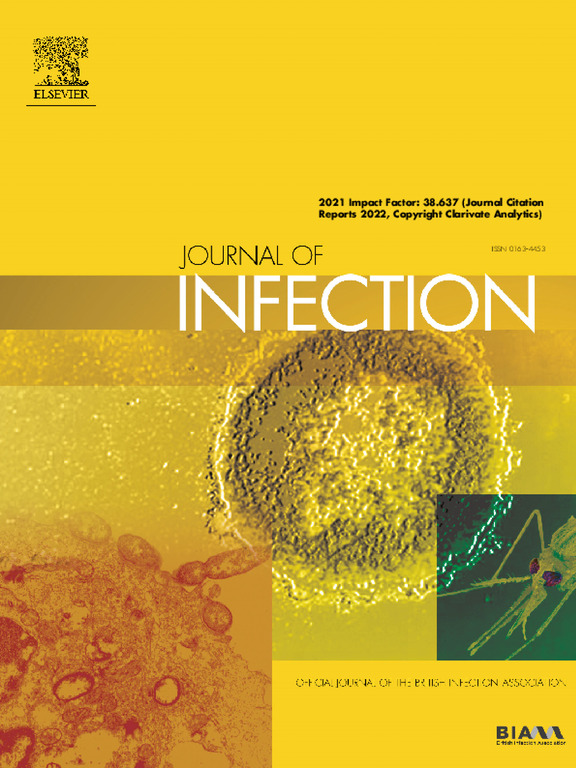第三,暴露于COVID-19感染或接种疫苗对T细胞反应的影响不同
IF 11.9
1区 医学
Q1 INFECTIOUS DISEASES
引用次数: 0
摘要
2021年,两剂SARS-CoV-2疫苗的快速推出降低了COVID-19的严重程度和死亡率。然而,作为主要加强计划的进一步疫苗剂量有限,并且到2021年底取消公共卫生限制往往导致感染,而不是疫苗作为第三次暴露。目的比较两剂疫苗后通过mRNA增强或SARS-CoV-2感染第三次暴露对体液和细胞免疫的影响。方法:我们比较了uchl - crick Legacy队列研究(NCT04750356)的健康成人在第三次暴露后的免疫反应,分别接受祖传棘突编码mRNA增强剂(疫苗免疫,n = 38)和COVID-19感染(混合免疫,n = 13)接种两剂疫苗。使用活病毒中和试验、IFN-γ ELISpot、Luminex试验、流式细胞术和质量细胞术评估免疫谱。结果在感染或第三次接种疫苗后,总抗刺突IgG和变异特异性中和抗体具有可比性。总的来说,T细胞群相似,但功能不同。疫苗组CD8 +效应记忆(TEM)细胞在SARS-CoV-2刺突肽刺激后CD69和颗粒酶B的表达更高。相比之下,杂交组在刺激后产生更高水平的先天免疫相关细胞因子IL-10和IL-34,以及T细胞归巢趋化因子CCL25。虽然两种暴露对SARS-CoV-2变体的保护程度相当,但我们的研究结果表明,第三次暴露的途径会影响免疫反应的不同方面,因此需要进一步研究全身和粘膜部位的长期免疫。本文章由计算机程序翻译,如有差异,请以英文原文为准。
Third exposure to COVID-19 infection or vaccination differentially impacts T cell responses
Background
In 2021, the rapid rollout of two doses of SARS-CoV-2 vaccines reduced COVID-19 severity and mortality. However, further vaccine doses as a prime-boost schedule were limited, and lifting of public health restrictions by late 2021 frequently led to infection, rather than vaccine, as a third exposure.
Objective
To compare how the third exposure through mRNA booster or SARS-CoV-2 infection shapes humoral and cellular immunity following two vaccine doses.
Methods
We compared immune responses after the third exposure in healthy adults enrolled in the UCLH-Crick Legacy cohort study (NCT04750356) between those receiving ancestral spike-encoded mRNA booster (vaccine immunity, n = 38) or COVID-19 infection (hybrid immunity, n = 13) following two vaccine doses. Immune profiles were evaluated using live virus neutralization assays, IFN-γ ELISpot, Luminex assay, flow cytometry and mass cytometry.
Results
Both total anti-Spike IgG and variant-specific neutralising antibodies were comparable following infection or vaccine as a third exposure. Overall, T cell populations were similar but functionally different. CD8⁺ Effector Memory (TEM) cells in the vaccine group showed higher expression of CD69 and Granzyme B following stimulation with SARS-CoV-2 Spike peptides. In contrast, the hybrid group produced higher levels of innate immune associated cytokines IL-10 and IL-34, as well as the T cell homing chemokine CCL25, after stimulation.
Conclusions
While both exposures generated comparable breadth of protection against SARS-CoV-2 variants, our findings suggest that the route of third exposure influences different aspects of the immune response, warranting further investigation into long-term immunity at both systemic and mucosal sites.
求助全文
通过发布文献求助,成功后即可免费获取论文全文。
去求助
来源期刊

Journal of Infection
医学-传染病学
CiteScore
45.90
自引率
3.20%
发文量
475
审稿时长
16 days
期刊介绍:
The Journal of Infection publishes original papers on all aspects of infection - clinical, microbiological and epidemiological. The Journal seeks to bring together knowledge from all specialties involved in infection research and clinical practice, and present the best work in the ever-changing field of infection.
Each issue brings you Editorials that describe current or controversial topics of interest, high quality Reviews to keep you in touch with the latest developments in specific fields of interest, an Epidemiology section reporting studies in the hospital and the general community, and a lively correspondence section.
 求助内容:
求助内容: 应助结果提醒方式:
应助结果提醒方式:


